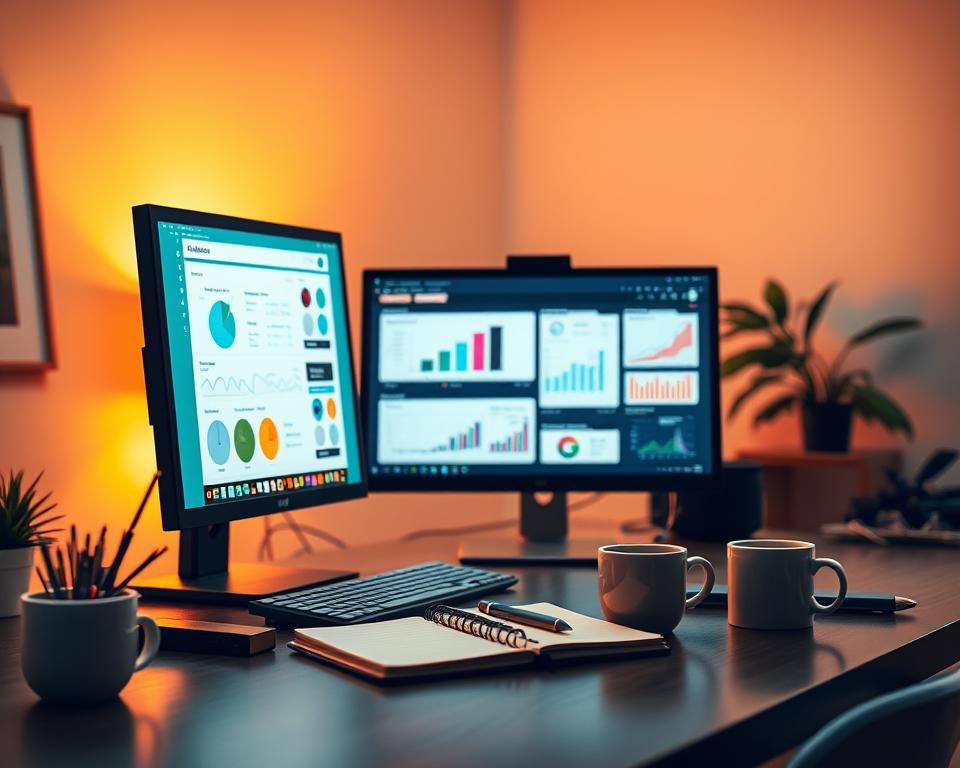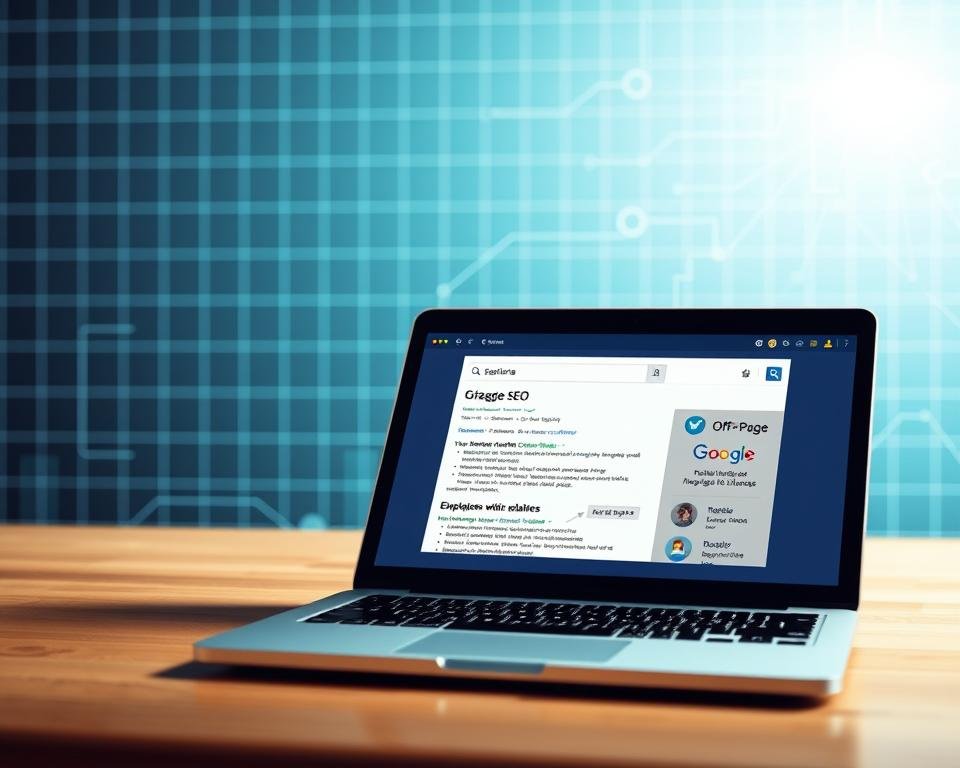Knowing about search engine optimization is key for digital marketing. On-page and off-page SEO are two main parts of SEO. They both aim to boost search rankings but work in different ways.
On-page SEO makes a website better for search engines by tweaking content and meta tags. Off-page SEO looks at things outside the site, like backlinks and social media, to affect rankings. This article will explore the main differences between these SEO methods, sharing SEO best practices.
Key Takeaways
- On-page SEO involves optimizing website elements for search engines.
- Off-page SEO focuses on external factors influencing site rankings.
- Understanding both strategies is crucial for a comprehensive SEO approach.
- Effective SEO requires a balance between on-page and off-page techniques.
- Staying updated with the latest SEO best practices is essential for success.
What is On-Page SEO?
On-page optimization is key to a good SEO strategy. It makes a website friendly to search engines. This is important for digital marketing.
Definition and Importance
On-page SEO makes web pages better for search engines. This improves their ranking. It’s vital for how search engines see your site.
Key aspects of on-page SEO include content, meta tags, and site structure. These improve your site’s ranking.
Key Elements of On-Page SEO
Several elements are important for on-page SEO. These include:
- Meta tags: Give search engines info about your webpage.
- Header tags: Organize content for better reading.
- Content quality: Good content is key for users and search engines.
- Site structure: A good structure helps search engines crawl your site.
- URL optimization: Descriptive URLs help your ranking.
| Element | Description | Importance |
|---|---|---|
| Meta Tags | Provide information about the webpage | High |
| Header Tags | Organize content for readability | Medium |
| Content Quality | Engage users and improve SEO | High |
| Site Structure | Facilitate crawling and indexing | High |
Common On-Page SEO Techniques
Webmasters use many techniques for on-page SEO. Some common ones include:
- Keyword research: Find relevant keywords.
- Content optimization: Make content high-quality and informative.
- Internal linking: Link to other pages on your site.
- Image optimization: Use descriptive alt tags and file names.
- Mobile-friendliness: Ensure your site works well on mobile.
Using these techniques can boost your site’s visibility. It can drive more traffic and improve rankings.
What is Off-Page SEO?
Off-page SEO is about improving your website’s reputation online. It’s different from on-page SEO, which makes your site search engine friendly. Off-page SEO focuses on external signals that boost your site’s credibility and ranking.
Definition and Importance
Off-page SEO means doing things outside your website to boost its ranking. It includes building high-quality backlinks, improving social signals, and enhancing local SEO. It makes your website more trustworthy to search engines.
By working on off-page SEO, I can make my website more visible. This leads to more traffic and a stronger online presence. It’s crucial to keep these efforts in line with my SEO strategy.
Key Elements of Off-Page SEO
The main parts of off-page SEO are:
- Backlinks: Links from other sites that show my site is credible.
- Social Signals: My brand’s activity and engagement on social media.
- Local SEO: Making my site better for local searches by using consistent NAP (name, address, phone number).

Common Off-Page SEO Techniques
Some common off-page SEO methods are:
- Link Building: Getting backlinks from trusted sites.
- Social Media Marketing: Using social media to boost brand awareness and site traffic.
- Influencer Outreach: Working with influencers to promote my content and products.
Using these techniques can improve my website’s online presence and rankings.
Comparing On-Page and Off-Page SEO
To get your website to rank higher, you need to know about on-page and off-page SEO. On-page SEO makes your website better for search engines. Off-page SEO builds your website’s reputation online.
What Sets Them Apart?
On-page SEO focuses on your website’s structure and content. It makes your site easy for search engines to understand. This includes using the right keywords, optimizing meta tags, and making sure your site works well on mobile devices.
Off-page SEO, on the other hand, works on making your website more popular. It involves getting more links, using social media, and managing your online reputation. On-page SEO makes your site better, while off-page SEO makes it more popular.
How They Complement Each Other
On-page and off-page SEO work together well. A well-optimized website attracts more backlinks, showing search engines it’s trustworthy. This makes your site more visible online.
A strong off-page SEO strategy brings more visitors to your site. This gives you a chance to improve your on-page metrics. A balanced approach to both on-page and off-page SEO is key for a high ranking in Google.
By using both on-page and off-page SEO, you can make your website more visible. This drives more traffic and boosts your online presence.
The Role of Keywords in On-Page SEO
Keywords are key in on-page SEO. They connect what users search for with the content they find. By picking the right keywords, businesses can make their websites more visible on search engines.
Good keyword research is the base of a strong on-page SEO plan. It finds the terms your audience uses to look for what you offer. This helps create content that speaks to your audience and answers their needs.
Importance of Keyword Research
Keyword research is vital because it:
- Shows what your target audience searches for.
- Finds the right terms to use in your content.
- Makes your website more visible on search engine results pages (SERPs).
To do deep keyword research, use tools like Google Keyword Planner, Ahrefs, or SEMrush. These tools give you info on search volume, competition, and related keywords. This helps you make smart choices.
Placement of Keywords
After finding your target keywords, place them wisely in your content. This means:
- Page Title: Put your main keyword in your page’s title.
- Meta Description: Use keywords in your meta description to draw in users and boost click-through rates.
- Headings: Add keywords to headings (H1, H2, H3, etc.) to organize your content and highlight key points.
- Body Content: Mix keywords into your content’s body, keeping it easy to read and interesting.
A well-organized table can show the best places for keywords:
| Keyword Placement | Importance Level | Example |
|---|---|---|
| Page Title | High | “Best Italian Restaurants in New York” |
| Meta Description | High | “Discover the top Italian restaurants in New York. Read reviews and make a reservation.” |
| Headings | Medium | “Top 5 Italian Restaurants in New York City” |
| Body Content | Medium | “When it comes to Italian cuisine, New York City has a lot to offer. From authentic pasta dishes to pizza, the city is home to numerous high-quality Italian restaurants.” |

By focusing on keyword research and smart keyword placement, you can greatly boost your website’s on-page SEO. This drives more targeted traffic to your site.
The Role of Backlinks in Off-Page SEO
Off-page SEO uses backlinks to boost a website’s online presence and ranking. Backlinks are links from other sites to yours. They help show a site’s trustworthiness and authority.
Significance of High-Quality Backlinks
High-quality backlinks are key for off-page SEO. They tell search engines your site is trustworthy and relevant. These links come from sites with a strong reputation and match your content.
Key benefits of high-quality backlinks include:
- Increased website credibility
- Improved search engine rankings
- Enhanced online visibility
Strategies for Building Backlinks
Getting high-quality backlinks needs a smart plan. Here are some good strategies:
- Guest Blogging: Write guest posts for well-known sites in your field to get backlinks.
- Broken Link Building: Find broken links and offer to replace them with a working link to your site.
- Leveraging Relationships: Build connections with other site owners and influencers in your field for backlink chances.
To show the difference of backlinks, look at this comparison:
| Factor | Low-Quality Backlinks | High-Quality Backlinks |
|---|---|---|
| Source | Spammy or irrelevant sites | Authoritative and relevant sites |
| Impact on SEO | Negative impact or no effect | Positive impact, improved rankings |
| Credibility | Low credibility | High credibility |

In conclusion, backlinks are crucial for off-page SEO. By getting high-quality backlinks through smart methods, you can make your site more credible, rank better, and be more visible online.
Content Quality: On-Page SEO Focus
Content quality is key in on-page SEO. Search engines now focus more on quality, relevant, and engaging content. This is crucial for a website’s visibility and ranking.
The Importance of Original Content
Original content is vital for good on-page SEO. Search engines value unique and relevant content that adds value to users. Using the same content or copying it can harm a website’s credibility and rankings.
To make original content, aim to share insightful info, cite sources when needed, and avoid duplication.
Also, original content helps a brand stand out in its field. By consistently making high-quality, original content, businesses can gain trust and boost their online image.

User Engagement Metrics
User engagement metrics are important for judging on-page SEO success. Metrics like time on page, bounce rate, and pages per session show how users interact with content. A high bounce rate might mean the content doesn’t meet the audience’s needs.
Creating content that connects with the audience is key. Understand what the audience wants and needs. This way, businesses can make content that meets those needs, improving user engagement and SEO.
Also, these metrics help spot areas for improvement. By analyzing them, businesses can make better content choices. This leads to better on-page SEO efforts.
Social Signals in Off-Page SEO
Social signals are key in off-page SEO. They show how credible and relevant a website is. Knowing how social media affects SEO is vital for any digital marketing plan.
Impact on SEO
Social media is now a big deal for sharing and finding content. When content gets shared, liked, or commented on, search engines see it as valuable. The direct effect of social signals on SEO rankings is still up for debate. But their indirect benefits are clear.
Key indirect benefits include:
- Increased visibility and reach for your content
- Enhanced brand awareness and credibility
- Potential for generating high-quality backlinks
- Improved user engagement metrics
Strategies for Enhancement
To make the most of social signals, try these strategies:
Creating Shareable Content: Make content that’s interesting, fun, or touches people’s hearts. Think about infographics, videos, or in-depth articles.
Leveraging Social Media Platforms: Be active on the right social media sites. Post your content often and talk back to your followers.
| Platform | Primary User Demographics | Content Type |
|---|---|---|
| Diverse, with a wide age range | Varied, including videos, images, and text posts | |
| Younger adults, professionals | Short-form text posts, images, and videos | |
| Younger demographics | Visual content, including images and stories |
By knowing how social media affects SEO and using strategies to boost social signals, businesses can get more online visibility and trust. As the digital world keeps changing, keeping up with social media marketing is key to staying competitive.

Internal Linking in On-Page SEO
Internal links are key in on-page SEO. They help search engines see your site’s structure and what’s important. By linking to other pages, you make your site easier to use and navigate.
Benefits of Internal Links
Internal linking has many advantages:
- Improved Site Navigation: It helps users find more content, making their visit better.
- Link Equity Distribution: It spreads link value, helping other pages rank higher.
- Better Crawlability: Search engines can find and index your pages faster.
Best Practices for Internal Linking
To get the most from internal linking, follow these tips:
- Use Descriptive Anchor Text: Choose anchor text that’s clear and relevant.
- Link to Relevant Pages: Make sure links are useful and add value.
- Avoid Over-Linking: Don’t link too much. Only link to pages that are truly relevant.
Good internal linking is essential for a well-organized site. It helps both users and search engines understand your site’s layout.

With a smart internal linking plan, you can boost your site’s SEO and user experience. Focus on being strategic and user-friendly with your links.
The Impact of User Experience on On-Page SEO
User experience is key to on-page SEO success. A website that offers a good user experience ranks higher in search results.
Page Load Speed and SEO
Page load speed is very important for user experience. A slow website can cause people to leave quickly, hurting SEO. To make pages load faster, several steps can be taken.
- Optimizing images to make them smaller
- Leveraging browser caching to keep often-used resources
- Minimizing HTTP requests by having fewer elements on a page
By using these methods, websites can load faster. This makes users happy and helps with SEO.
Responsive Design
Responsive design is also very important. Most people use mobile devices to visit websites. A responsive design makes sure a website works well on all screens.
Key parts of responsive design are:
- Flexible grids that fit different screen sizes
- Flexible images that change size as needed
- Media queries that change styles based on device
By using responsive design, websites can offer a great experience on all devices. This helps with on-page SEO.

Building Authority with Off-Page SEO
In today’s digital world, off-page SEO is key for brands wanting to be seen as trustworthy online. Off-page SEO uses many strategies to show search engines a brand’s trustworthiness and relevance.
Establishing Trustworthiness
Making a brand seem trustworthy is complex. It involves showing a consistent and positive image online. This means all your online spots, like social media and review sites, should look the same.
Creating high-quality content is also vital. It should be informative, fun, and match what your audience likes. This helps a lot in making your brand seem credible.
Brands should also share content that shows they know a lot about their field. This builds trust and creates a loyal group of followers.
Reputation Management Strategies
Keeping a good online image is crucial. This means watching online reviews, fixing bad feedback fast, and sharing good stuff. This way, brands can avoid bad online news and keep their image strong.
Some important ways to manage your reputation include:
- Watching review sites and social media for mentions of your brand
- Answering customer feedback quickly and nicely
- Sharing good content through different ways
- Reaching out to people to make your brand look good
Using these methods, brands can handle their online image well. This helps them attract and keep customers.
Measuring Success: On-Page vs. Off-Page SEO
It’s key to know how well on-page and off-page SEO work. This helps you make smart choices for your SEO plan. You need the right tools to track and analyze both areas.
On-page SEO makes your website better for search engines. To see if it’s working, you must watch different metrics.
Tools for Tracking On-Page SEO
Many tools help track on-page SEO. Some top ones are:
- Google Search Console: Shows your site’s search rankings, views, and clicks.
- SEO Audit Tools: Ahrefs, SEMrush, and Moz do deep checks to spot what needs work.
- Google Analytics: Tracks your site’s visitors, how they engage, and what they do next.
These tools help you see if your on-page SEO is working. You can then make choices based on real data.
Tools for Analyzing Off-Page SEO
Off-page SEO builds your site’s reputation and authority. To see how well it’s doing, you need to look at certain metrics.
- Ahrefs Backlink Checker: Looks at your site’s backlinks, their number and quality.
- Moz Open Site Explorer: Gives insights into your site’s backlinks and domain authority.
- SEMrush: Helps analyze social media, brand mentions, and other off-page factors.
With these tools, you can see how well your off-page SEO is doing. You can also find what needs more work.
In short, to measure on-page and off-page SEO success, you need to know about the tools and metrics. By using these tools, you can make your SEO better. This will help your website rank higher in search engines.
Future of SEO: Trends in On-Page and Off-Page
Search engines are getting smarter, changing the SEO world. Knowing what’s next in SEO is key for success. It helps drive more traffic and keep people engaged.
Algorithm Evolution
Search engine algorithms are getting better at finding what you need. They look at many things, like how good your content is and how easy your site is to use. This change affects both on-page and off-page SEO.
Understanding User Intent
User intent is now super important in SEO. Focusing on what users want helps improve your site’s ranking. It also makes your content more valuable to your audience.
To keep up, it’s important to know the latest SEO trends. Adapting your strategies to these changes helps your business stay strong online. This way, you can keep growing in the digital world.
